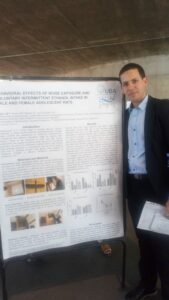Sleep paralysis is defined as a period of transitory immobility which occurs during sleep onset or offset. It is characterized by the inability to perform voluntary movements when the person feels awake and conscious about the environment. During an episode there may also be different types of hallucinations: The Intruder, characterized by the sense of an evil and threatening presence, and in some cases visual and tactile hallucinations. The Incubus, characterized by pressure on the chest and other body parts, breathing difficulties, feelings of suffocation, choking, pain and morbid thoughts of imminent death. Unusual body experiences which includes Illusory Movement Experiences (IMEs) and Out of Body Experiences (OBEs). IMEs are vestibular sensations such as the sensation of rolling or floating, and/or motor sensations of displacement without a visual component. The OBEs are an altered state of consciousness, defined as the experience in which an observer perceives the world from a point of view outside of their physical body. Unlike the other two components (incubus and intruder), during IMEs and OBEs the person may not feel body paralysis, and they are considered as “pleasant”. OBEs during sleep paralysis can occur spontaneously, or they can be induced by training. Here, we will discuss preliminary results of an online survey with subjects who had unusual sleep experiences, such as OBEs and Sleep Paralysis and its clinical implications.

Menu
E-poster
Session: 4
PS4-07 | Can we be “out” of our body? Characterization and clinical implications of out-of-body experiences during sleep paralysis: Preliminary results.
Nerea Herrero
Laboratorio de Sueño y Memoria - ITBA
- CABA,
- Argentina
- Nerea Herrero1
- , Francisco Gallo1
- , Cecilia Forcato1
- 1. Laboratorio de Sueño y Memoria, Depto. Ciencias de la Vida, Instituto Tecnológico de Buenos Aires (ITBA)
- 2. Consejo Nacional de Investigaciones Científicas y Técnicas (CONICET).
- 3. ENYS-CONICET, Universidad Nacional Arturo Jauretche, Hospital de Alta Complejidad en Red El Cruce “Néstor Kirchner”, Argentina.
